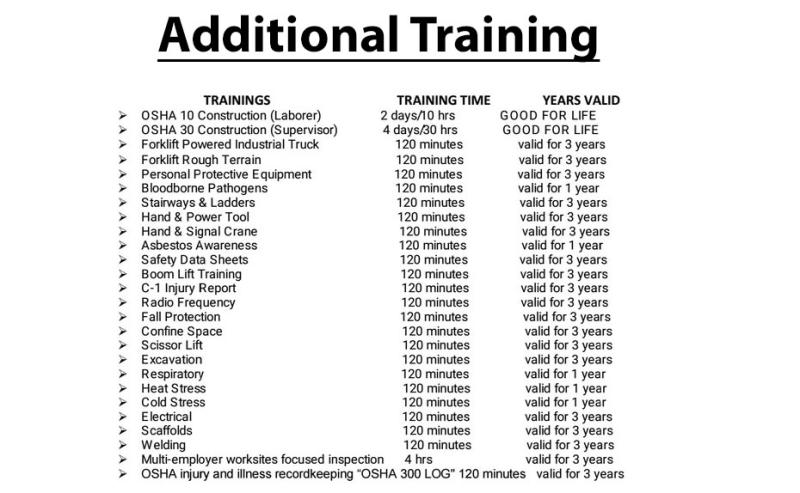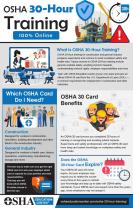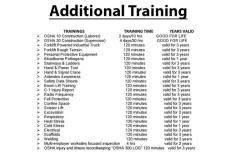What training is required every year by OSHA?
The Occupational Safety and Health Administration (OSHA) does not have a specific requirement for annual training for all workplaces. However, OSHA does have specific training requirements that employers must fulfill to ensure a safe and healthy workplace. The frequency of these trainings varies depending on the type of workplace hazards and the specific OSHA standards applicable to the industry. Employers are responsible for assessing the training needs in their workplaces and providing the necessary training accordingly.
Here are some key OSHA training requirements that may need to be addressed on an annual basis or more frequently, depending on the circumstances:
Hazard Communication (HazCom) Training:
- Employers are required to provide hazard communication training to employees who may be exposed to hazardous chemicals. This training is typically required at the time of initial assignment and whenever new hazards are introduced into the workplace.
Bloodborne Pathogens Training:
- Employees at risk of occupational exposure to blood or other potentially infectious materials must receive bloodborne pathogens training. This training is typically provided annually.
Respiratory Protection Training:
- Employees required to use respirators must receive training on the proper use, limitations, and maintenance of respirators. This training is required annually.
Fire Extinguisher Training:
- While OSHA does not have a specific standard mandating annual fire extinguisher training, it is a good practice for employers to provide periodic refresher training to ensure that employees understand how to use fire extinguishers effectively.
Emergency Action Plan (EAP) Training:
- Employers must have an EAP and provide training to employees on emergency procedures. While there is no specific frequency requirement, training should be provided when the plan is developed or whenever roles and responsibilities change.
Lockout/Tagout Training:
- Employees exposed to hazardous energy sources must receive training on lockout/tagout procedures. This training should be provided when employees are initially assigned to a job with potential exposure and periodically thereafter.
Fall Protection Training:
- Employees exposed to fall hazards in construction must be trained on fall protection. Training frequency may vary depending on the specific fall hazards present and changes in the workplace.
Confined Space Entry Training:
- Employees involved in confined space entry must receive training on hazards, procedures, and equipment. Training should be provided before initial assignment and when there are changes in procedures or hazards.
It's important to note that the frequency of training may be influenced by changes in the workplace, new hazards, or changes in job assignments. Employers are responsible for conducting regular assessments of their workplaces to determine the need for additional or refresher training. Additionally, specific OSHA standards may have unique training requirements applicable to certain industries or activities.
Employers should refer to the OSHA standards relevant to their industry and consult with OSHA's guidelines to ensure compliance with training requirements specific to their workplace.
What specific annual training does OSHA mandate for workplaces?
While OSHA has a plethora of regulations and standards outlining various training requirements, it's not entirely accurate to say that OSHA mandates specific annual training for all workplaces. The type and frequency of training required depends on several factors, including:
General Training:
- Bloodborne Pathogens & Exposure Control: For workers with potential exposure to infectious materials, annual refresher training is recommended.
- Hazard Communication Standard: While initial training is mandatory, annual refreshers are not explicitly required; employers must ensure employees understand the program and maintain proficiency.
- Some other standards also recommend annual refresher training, like Respiratory Protection (for respirator users) and Lockout/Tagout (for specific situations).
Industry-Specific Training:
- Many OSHA standards outline mandatory training for specific industries or tasks, with varying frequencies. Examples include:
- Construction: Fall Protection Training must be repeated every three years, while Confined Space Training might be annual depending on specific risks.
- Maritime: Basic Safety Training and Survival Craft/Rescue Boat Drills are annual requirements for certain personnel.
Additionally:
- OSHA emphasizes "training necessary to ensure employee safety", meaning employers must assess workplace hazards and provide training specific to the identified risks, regardless of frequency.
- Certain employer practices or circumstances might necessitate more frequent training than standard requirements, like changes in processes, new equipment, or accidents.
Resources for Determining Required Training:
- Consult specific OSHA standards applicable to your workplace. Each standard outlines training requirements, if any.
- Visit OSHA's Training Requirements in OSHA Standards document: https://www.osha.gov/sites/default/files/publications/osha2254.pdf
- Contact your local OSHA office or a qualified safety professional for guidance.
Remember, adequate training is crucial for workplace safety. While there may not be a singular "annual training" mandate for all workplaces, complying with relevant standards and ensuring employees have the necessary knowledge and skills to work safely is paramount.
I hope this clarifies the situation! Feel free to ask further questions if you need more specific information about training requirements in your field.







